Text
Final Adrian Mole Design
After making lots of small changes to the design, I have now finished it. I'm happy with how it looks as it reflects the book and the colours and typography make is stand out.

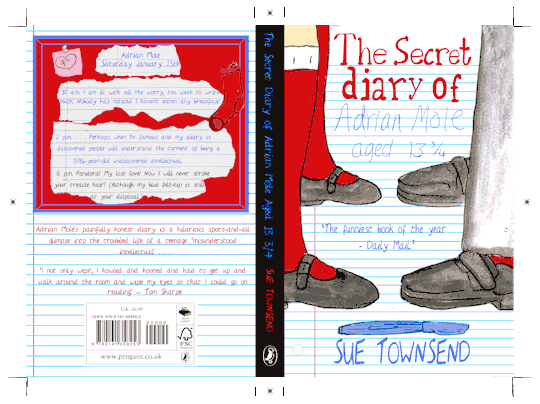
The final design:

#Illustration#childrensillustration#childrensbooks#adrianmole#suetownsend#bookcoverdesign#final outcome#design development#redsocks#penguindesignawards
0 notes
Photo
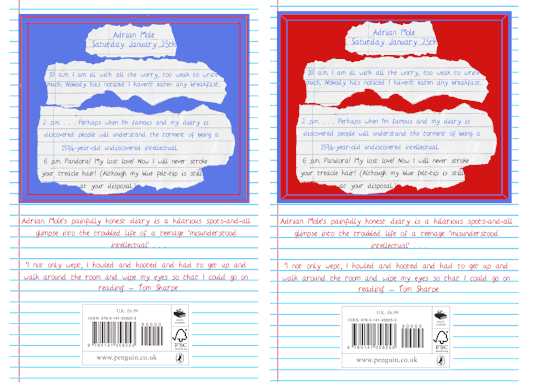

Designs for the back cover of the book. I wanted to develop an earlier idea for the front cover of having a pin board with text on so I scanned in bits of ripped paper and then added the rest in digitally. I think that the lined paper works better as it will link the front and back covers together. Also the red pin board works better as it pushes the text forward.
#bookdesign#childrenbookillustration#adrianmole#suetownsend#backcover#Illustration#photoshop#diaries
1 note
·
View note
Text
More Adrian Mole Development
With these designs I'm using my best idea to now experiment with text and colour.




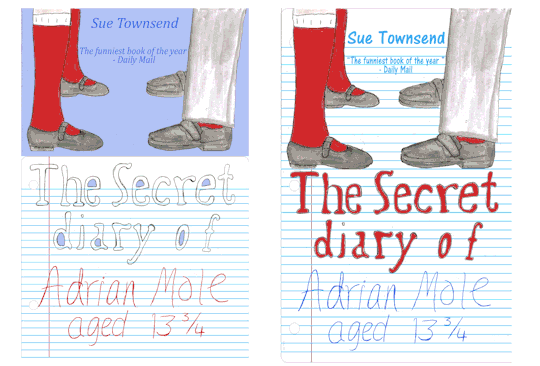
After deciding that I wanted to use the lined paper in the background, I then refined my cover by rewriting the title and then editing it in photoshop so that the lines were sharper.

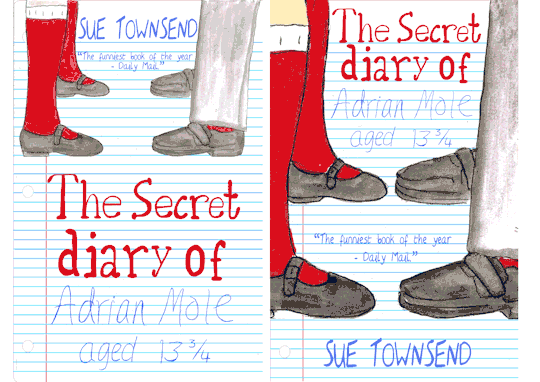
I think that the edited text has really improved the appearance to make it look better presented as a whole. However then I thought that the imagery looked too small in comparison to the text and so I experimented with changing the size of the legs so that they take up more of the cover. I think that this design is better as it comes together as a whole, making it look more like a book cover. Also I prefer the title of the book being at the top as it works better with the lined paper idea.
#illustration#bookcoverdesign#adrianmole#suetownsend#penguindesignawards#linedpaper#ideadevelopment#childrensbooks
0 notes
Photo
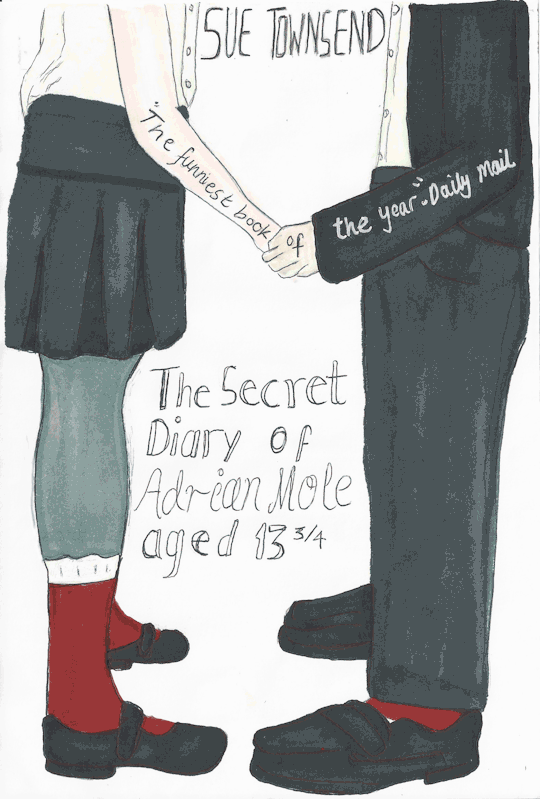
Another Adrian Mole design. Further experimentation of the red sock idea but including more of the two main characters on the cover rather than just their feet and part of their legs. By including more of the characters it makes it easier to show the romance between them and will fit the whole length of the book. However this will leave less room for the title, which is the most important bit. Therefore I may need to experiment with the composition more so that there is more of a balance between text and image.
#Illustration#childrensbooks#adrianmole#suetownsend#schooluniform#bookcoverdesign#drawing#characters
0 notes
Photo

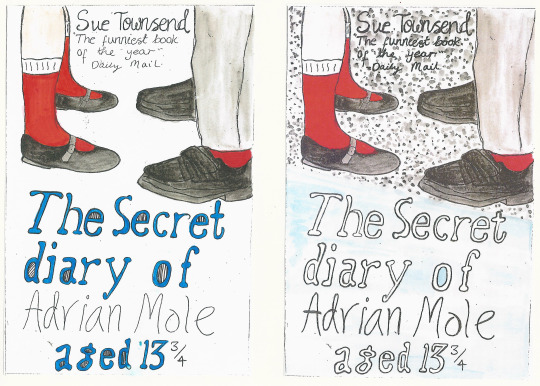


Another Adrian Mole design where I have experimented with one of the main themes in the book; the protest over Adrian Mole’s red socks. ‘I was feeling rebellious, so I wore red socks.’ I think that this design works well in reflecting the story of the book. Seeing as there wasn’t a lot of descriptions and imagery actually in the book this is the one bit that stood out to me.

After speaking to my tutor about the design I tweaked it slightly so that both the feet were in line with each other and the writing was straight, making the whole appearance look a bit neater.
#illustration#book cover design#childrensbooks#childrensillustration#penguindesignawards#redsocks#adrianmole#suetownsend#development
0 notes
Photo

For an editorial workshop at uni, we received 1/3 articles about cycling. Mine was titled ‘Meatpacking’ and was about ‘enthusiastic riders and food enthusiasts‘ and how they combined the two. This included cooking meat and steaming mussels actually on the bikes. Looking on the Larry vs Harry website I found lots of photos from their trip which helped me to develop this outcome which really does combine the two. I think that to improve this I would have include a background colour as when looking at the rest of my classes designs, the best ones were where the whole image was full bleed.
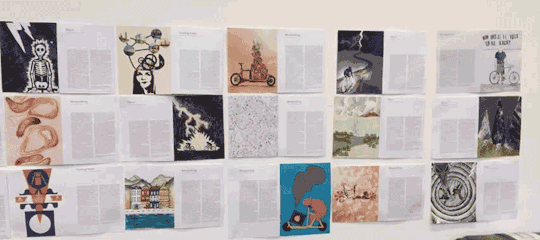
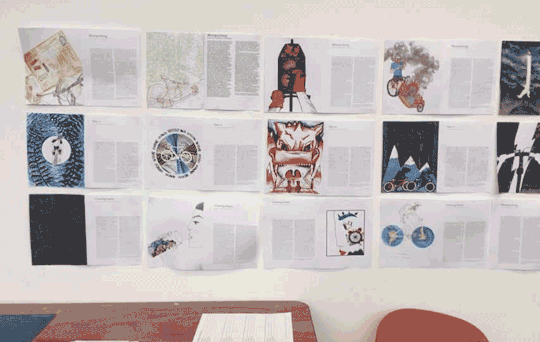
0 notes
Photo

Another initial idea for Adrian Mole. In one of his diary entries he went to Scotland and whilst he was there bought a new tartan diary. I developed this idea by using the two main colours in the book; the red of the socks and the blue pen that he lends Pandora. Although this cover would stand out on a bookshelf I think that more imagery from the book could better reflect themes in it.
#bookdesign#childrensbooks#childrenbookillustration#Illustration#uni student#adrianmole#bookcover#suetownsend
1 note
·
View note
Text
Report on Illustrators and the illustration industry

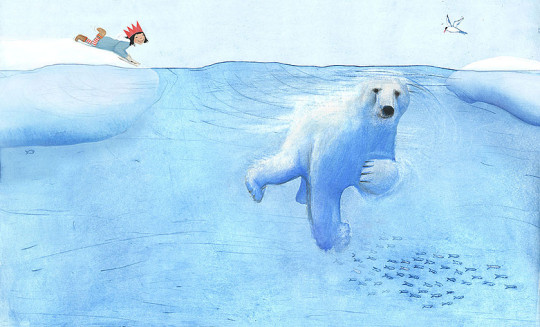
I had the great opportunity of interviewing both Jenni Desmond and Andrea Turvey about their work and career as illustrators. They’re very different in the work that they produce, however they have helped me to understand the illustration industry a little better, and what I may need to do to help get my work out there. There are a couple of similarities between the two: firstly they both have agents and secondly they both have ‘regular clients’. Jenni is a children’s book illustrator and author, with a number of awards that she has won for her drawing talent and storytelling, including the 2016 New York Times Best Illustrated Children’s Book. She says that as a result of winning these she has ‘definitely become more well known and job offers have definitely increased’, which is understandable when you look at her books and see how her illustrations really help to tell the story, whilst at the same time being informative and educational. Jenni is represented by Penny Holroyde, who helps ‘negotiate contracts’ for her which even she says herself ‘are a mine field.’ Having an agent for her is ‘essential and wonderful to let me get on with focusing on my work.’ Even with an agent she says that it can be difficult finding work as a freelance illustrator but that ‘it’s important to keep working, keep improving, keep trying.’ Her work ethic is something I admire as she has obviously worked hard to be as successful as she is now. She finds her motivation by using music as a tool. By using it to transport her to her imagination, she ‘dances around in her head and then draws the characters dancing around too, which gives them lots of movement and life’. She also engages with the audience of her books by doing workshops with primary school children. She loves inspiring them and seeing them enthusiastically reading her books, which help to remind her ‘why I am doing my job’. Her passion for what she does can really be seen in the attention to detail and well thought out compositions, which create a calming yet exciting feel throughout her books; transporting the reader to the place that she is creating; sharing her imagination with them.
Andrea mostly does editorial work, specialising in food illustration for magazines such as Delicious, Jamie magazine and Tesco. ‘Food is my comfort zone so I find this the easier subject to work with.’ She is usually approached either directly or through her agent, then once the brief and fees are agreed she will develop more detailed deadlines for roughs and final illustrations. Her first commission was for Jamie Magazine. ‘They found me online and got in touch, one of those lucky things. They wanted a double page illustration and some smaller spots. I was very excited and very nervous about it but it went well so when completed I asked if they would consider using me again and they gave me a regular feature which I did for about 5 years.’ This showed me that it's important to self promote and ask for feedback on projects as if they like it, it can lead to a long relationship with the company and lots more work. Unlike Jenni who has more creative freedom as the publisher just helps to develop the ideas, Andreas work is commissioned differently as she has to work to the requirements of the client. This means that she has stricter guidelines in terms of layout as the client gives the sizes and spaces to fill. ‘Sometimes there is room for slight creative freedom, as in allowing an image to run to the edges of the page or behind the copy.’ Andrea gets lots of small commissions which have a quick turnaround. Jenni said that the average time for her to write and illustrate a book is about two years. This showed me that there is huge variation within illustration depending on the types of commissions you receive. I think it's important to be flexible and try to be open to any commission as small commissions can be quicker income and more enjoyable as the subject/brief will always be changing, but also longer commissions mean you can really develop and perfect ideas. Both artists draw and then edit them digitally. I think this is important as it enhances the illustrations and the colour, and helps experiment with format and neaten everything before printing.
Overall they have helped me to realise that getting an agent either straight out of uni or a couple of years after would be a good way to get my work out there and help with contracts and make sure that the money is right. Also, getting on with self promotion work towards the end of third year will help to get jobs when I finish uni. Continuing to post work on social media will also her promote my work.
To read the full interview with Jenni and Andrea click the links below:
https://jadesmithillustration5.tumblr.com/post/156078441505/interview-with-jenni-desmond-jenni-very-kindly
https://jadesmithillustration5.tumblr.com/post/156051339390/interview-with-andrea-turvey-for-a-group-project
To see more of their work visit their websites at:
http://www.jennidesmond.com/
http://www.andreaturveyillustration.com/
#report#illustration#uni student#interview#illustrators#artists#Jenni Desmond#andreaturvey#foodillustration#childrensbookillustration
0 notes
Photo
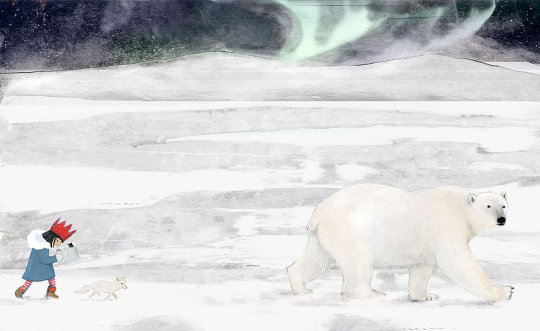


Interview with Jenni Desmond
Jenni very kindly agreed to let us interview her and answered questions about how she started out as an illustrator, her work process, her most well known books, how commissions work and other general arty things that we were interested in finding out. With her in depth answers she really helped to inform me about the children’s book and illustration industries which I'm sure will help me in developing my own career.
You do a lot of workshops with primary schools. What do you find interesting about working with children?
As my books are for children it’s important to engage with my audience! Sometimes they say funny things that make me laugh. When they are enthusiastic about the book or about meeting me and I feel I can inspire them, they remind me why I am doing my job. I would have loved to have had a visiting author when I was little and I think I would have been very inspired by one so I try to remember that. (School trips also pay well!)
For ‘The First Slodge’ you collaborated with Jeanne Willis, as you have done on a few other books. How was it to work with her? Is it similar to editorial illustration? Do you have any influence over the narrative being written?
I have no influence on the worded narrative, although I do try to 'write' a lot of extra information into the book with images. I have no engagement with the author. We met on email only a few months ago in fact and I've never met her in person. She seems lovely though. Everything is done through the publisher. When I've done the roughs etc the publisher sends the work to her for the okay.
You’ve won both the 2015 Best Emerging Talent (illustrator) at the Junior Design Awards and the 2016 New York Times Best Illustrated Children’s Book. How did winning each of these awards effect your reputation as an illustrator? Did you receive any commissions as a result?
I'm sure it does effect things. It's always hard to tell how people found me etc but in the last year I have definitely become more well known and my job offers have definitely increased!
What is the inspiration for your drawings? Do you use reference images? Do you use your own handwriting for your fonts?
I use my own handwriting. I use reference images at the beginning when I am researching an animal character to understand what shape it is. But then I just work from my head so I can insert the character without worrying about the shapes. Inspiration mostly from my personal life and relationships.
Last year, you were awarded the Maurice Sendak Fellowship. How was it? What was it like working alongside fellow illustrators handpicked for this award?
WONDERFUL, and we were treated so so well! The farm we stayed at was gorgeous and we had our own houses and studios and lots of engagement with sendak's original artwork and stories about him. The illustrators were lovely and very interesting people. It was nice to have the time to work in my sketchbook on my own stuff, I don't have time to do that these days- drawing is now work! Which is a good thing. Even though it’s a passion, it’s no longer a hobby.
What motivated you to go back and study the Masters in Children’s Book Illustration? What sort of things did you learn? Would you recommend it to anyone wanting to become an illustrator?
I didn't do a degree in illustration so felt I needed some training. It was very useful to learn the format of childrens books, learn about illustrators, be exposed to interesting ways of creating books, meet great people, improve my work.
How did you come up with the ideas for your non-fiction books? (The Blue Whale, The Polar Bear…)
I was just looking around the internet one day and found some facts about blue whales. I scribbled them down quickly with some sketches and then forgot about them until I showed the publisher, quite absent mindedly really, and she had the vision to turn it into a 4 book series. You never know what nugget of an idea could spark into something, so it’s good to keep sketchbooks and things.
For The Blue Whale, did you adapt an illustration to fit the cover, or did you design it specifically as the cover?
I had a vision of what the cover looked like from the start, it was one of the first sketches I did. In the end it’s also the same image as one of the spreads. But I always knew that’s what the cover would look like. (though the boat was a fishing boat at the beginning.)
How have you worked out a balance between producing art and having down time?
I used to go out to the pub lots and fill my evenings, now I mostly just work and then go home to chill. I don't work at home. Ever. Baths, cooking, watching films and hanging out with my partner occupy a lot of my down time. I now go swimming every lunchtime which is good for the mind as well as the body.
Of the work that you produce, would you say that picture books are your favourite?
Yes. I love that they have a use and are not just images, they are characters, stories, things to hopefully inspire children, and they are also objects. I do love books so it’s an honour to make them.
How do you go about promoting your work and exhibitions?
Gah... social media? but I am not very good at it. Mostly my agent does that stuff.
How did you come to be represented by your agency? Do they decide which work you should do? How do their fees effect your commission prices?
I was represented by an agency called Bright a few years ago, they picked me up at my grad show. I then moved to Penny Holroyde after being recommended her. It’s important to have the right agent, who you trust, it’s almost like having an extra parent or something, who always has your back and is with you the whole way. She advises me on what I should do. Her main job is to negotiate contracts which are a mine field. She will normally bump the fee up a bit which will normally just about cover her fees (15% plus vat). For me having an agent is essential and wonderful to let me just get on with focussing on my work. You can get a bit screwed over when starting out so do be careful with contracts, and use AOI for any advice on them.
Has it been difficult finding work as a freelance artist?
Sometimes. It gets easier the more well known you get. And the better you get! It’s important to keep working, keep improving, keep trying. It’s a pretty tough career to get in to. I sell things on etsy, which can be a good source of income. In general, the pay as an illustrator or picture book maker is a bit crap.
In an interview with playingbythebook.com you said ‘I use music as a tool. I find that it transports me to my imagination.’ How so?
I dance around in my head and then draw the characters dancing around too, which gives them lots of movement and life.
What inspired the move to London? Did you need more space than the studio you had in Brighton?
I wanted to be in the thick of it I think, and most of my friends were here. I'd gone to uni at sussex so had been in brighton for a while and I had run out of enthusiasm for it a little. The space I can get in Hackney is def smaller than Brighton - hackney studio spaces start at about £180 for a desk so it’s not cheap! I had a nice big space in south London (whirled art studios) when I first moved here and it was dirt cheap, I loved that place. Sadly it’s too far away now. But Hackney Downs is super great.
What has it been like to work with Enchanted Lion Books? What happens under a multiple book series deal like you have with them?
Wonderful, it’s a small publisher, pretty much a one woman band, and she is incredibly talented and bright and creative and she pushes me hard with her expectations and perfectionist ways. She's fantastic. A multiple book deal basically just means that once I've finished one then it’s on to the next. It’s nice to have the security of knowing you've got more work. The contract will be the same financially across all four books.
Do you find that thumbnails are particularly helpful in figuring out how a book will flow?
Thumbnails used to drive me nuts and I thought they were the most pointless thing ever. I've become more patient now though, and yes I now think they're helpful to work out the flow. I am still inclined to draw the whole thing out bigger though, as I like to see what’s going on and then ideas can flow from things you weren't expecting.
It took you about two years to make The Blue Whale, is this considered a short or long time?
Hmm... about average for writing and illustrating a book. Just illustrating, I could do something in 4 months. That's considered quick. I'm doing one in 3 months at the moment, that's quite stressful.
How is your next non-fiction book about elephants going?
I'm not properly starting until summer as I have two books to do first! Argh... I've done most of the research and writing though - elephants are the most incredible creatures. I can't wait to start.
You’ve designed the covers for two albums: The Diver’s Curse – BD Harrington and Standing Pat – The Dixie Traders. Did you get given a specific brief for them?
Yes I did actually, they both had specific ideas what they wanted. I find working for private clients a lot more stressful than publishers as they are so keen to get it perfect but aren't quite sure what that perfect they are looking for is. These covers were nice to do though.
Is it a conscious decision to have a fairly limited colour palette within each book?
I just don't really like bright colours very much! Except for bright blue and bright red. I just do what I like, and use the colours that I like. It's important to consider each colour that you use and not just use any old shade.
About The Tiger Protector for WWF you’ve said ‘it feels like a really important time to be creating books about endangered animals.’ Is creating work with a purpose and meaning significant to you?
Yes! I would do it even if I didn't think this though as I love to create art. I have to create art. But it is nice to have that too.
You worked closely with a marine biologist for The Blue Whale. Is making sure the facts are accurate a big part of your work ethic?
It's essential when creating non-fiction. I was paranoid about reviewers picking up on something incorrect. Luckily that hasn't happened. We weren’t going to work with one but I realised I was totally out of my depth when the editor kept asking if I was sure certain facts were correct. I am not a biologist and I had no idea. So I asked if we could get one on-board.
How do commissions work? Do you have a lot of freedom over the work you produce?
Private commissions? They tend to have a very rigid idea about what they want. When I'm working with publishers we will work together. I have the idea and do all of the backbreaking work, but I will constantly be back and forth with the publisher who will steer it in the right way. It depends on the publisher on how much or little they will do this. I don't really work with any publishers who are too pushy and in general I am left to do my own thing as much as possible. But it is essential to be open to feedback and open to doing changes. You can't get too precious about your work.
When you decided to become an illustrator how did you start getting your name and work heard of?
My grad show. My agent. Social media. Sending work out unsolicited. It’s hard starting out. You just have to keep plugging at it and keep producing new work and keep working hard. I was working on my artwork obsessively for years around the time of the MA and after. I found 2 years after I graduated was when I'd started getting into my grove and producing work I was happy with.
What was your first commission, how did you get it?
With Folens Publishers, an educational publisher in Ireland. I sent my work to them (and loads of others who declined me) and they gave me some work. I did loads of stuff with them in the end, for French text books.
To find out more about Jenni’s work check out her website: http://www.jennidesmond.com/
#illustration#interview#jenni desmond#childrensbooks#childrensillustration#animal books#thebluewhale#thepolarbear#illustrationstudent
2 notes
·
View notes
Photo
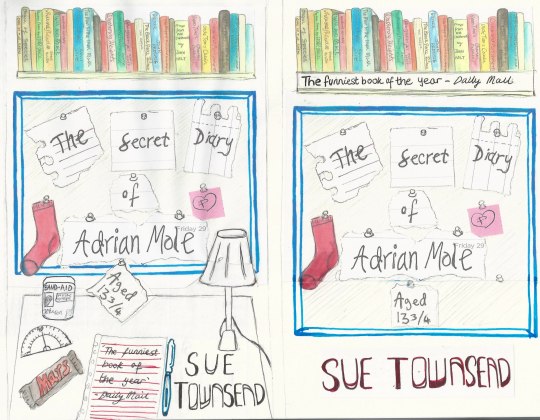
More development of the Adrian Mole book cover idea.
0 notes
Photo



Development of the bookshelf idea by changing colours and composition.
0 notes
Photo
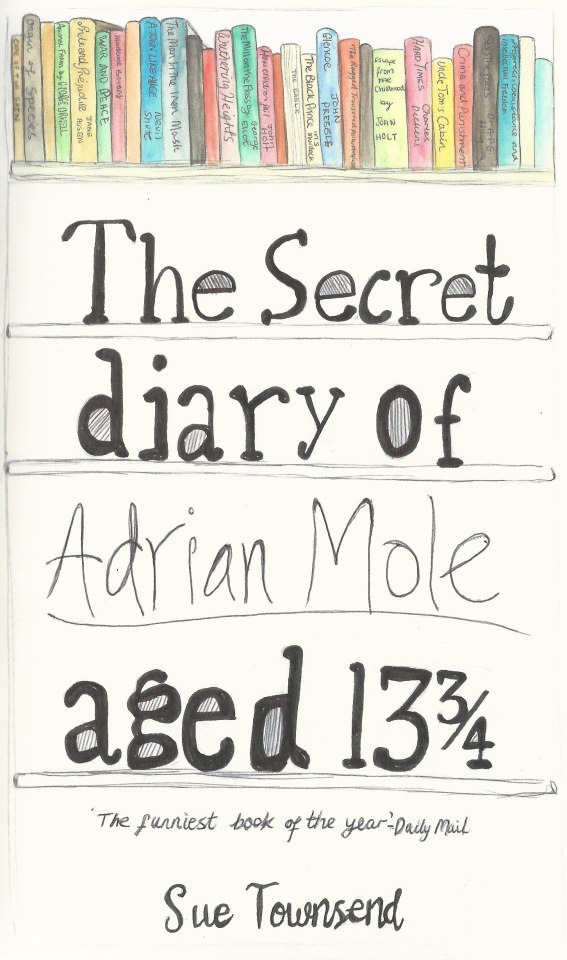
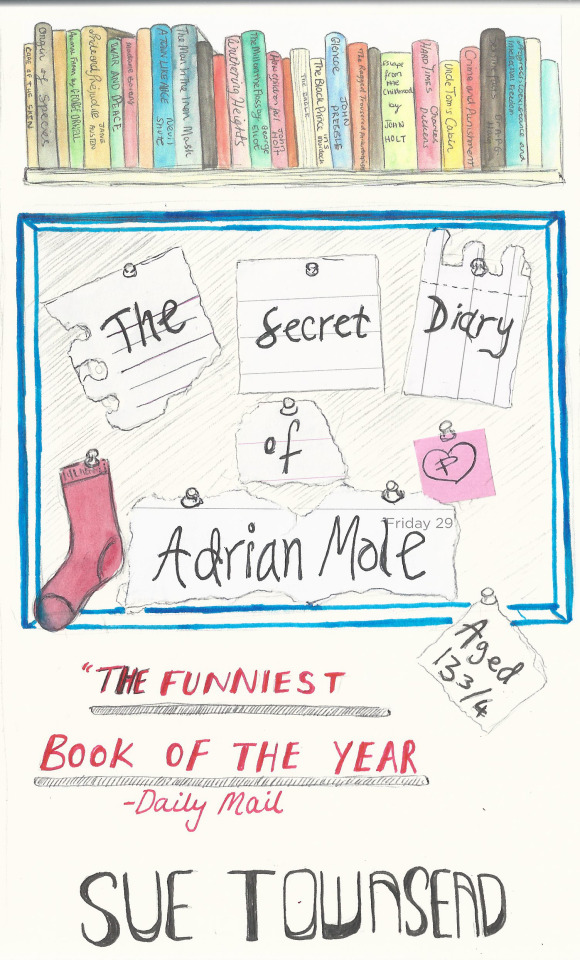
For my first design idea I decided to draw Adrian Mole’s bookshelf, as the constant theme throughout the book is all the different books he keeps reading. It is also one of the main characteristics that he thinks makes him an ‘intellectual’. Therefore I combined this idea with a font I thought represented him. I then developed this idea to include a couple of other items which are relevant to him in the book, e.g. the red sock.
0 notes
Photo


For part of the second unit of year 2, I am designing a book cover for ‘The Secret Diary of Adrian Mole aged 13 3/4′. I started the project my drawing some initial sketches based on quotes from the book that seemed important and somehow defined Adrian as a character. I may use these, with other themes in the book, to develop cover ideas.
1 note
·
View note
Photo



Customers inside the bakery
#art#illustration#bakery#customers#overheardconversations#photoshop#food#donuts#bread#gingerbread#documentary
0 notes
Photo


Illustrations of food inside the bakery
0 notes
Photo

Illustration of the outside of Celebration Cakes in Cranleigh as part of my documentary project.
1 note
·
View note